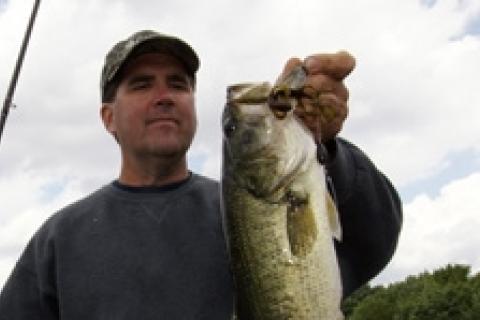
When it comes to finding largemouth bass during the summer — when many fish vacate the shallows for the food, cover and stability offered by deeper offshore areas — few offerings are as effective as the Carolina rig.
 |
| Veteran tournament angler Deron Eck with a largemouth taken on a Carolina rig. |
"The Carolina rig is great for searching out hard bottom areas like road beds, gravel flats, and stumpy points and flats," said Deron Eck, veteran tournament angler and winner of the 2010 FLW American Fishing Series event on Lake Erie.
Like an English Springer spaniel on the trail of a ringneck rooster, the heavy sinker of a Carolina rig sniffs out bottom changes and features, such as rock and stumps — places that often hold unpressured bass, wiring the information to the angler above. Behind the sinker, on the terminal end of a leader that can run from a 12 to 36 inches, one has the option of presenting soft baits of various sizes and profiles, based on the attitude of the fish and the water color being fished.
Eck — who heavily relies on the Carolina rig from the post-spawn through late summer — likes to have two such setups at hand. One will be a traditional "bubba-style" rig with a big 8-inch lizard or creature bait. The other will be more of a finesse setup, with a tube, fluke, French Fry or beaver.
"I use the same size weight for the finesse rig, but just drop down in bait size," he noted.
For the rig itself, Eck prefers bullet-shaped tungsten sinkers from 3/4 to 1-ounce. Leaders consist of 12- to 15-pound monofilament, which floats, helping to hold the bait off the bottom a bit. When heavy cover is present, he keeps the leader relatively short, from 1 1/2- to 2-foot to minimize hang-ups; in more open water he lengthens the snell to 2 1/2- to 3-foot.
The main line-to-leader connection is accomplished with a small swivel. Typically he strings a small hard-plastic bead up the main line, between the sinker and the swivel, to add some noise and protect the knot. When he wants to minimize the "clack" of the sinker/bead combo — at times bass will hit the sinker — he replaces the bead with a rubber bobber stop. He uses 17-pound fluorocarbon — which has minimal stretch, telegraphing bottom information and bites well — as the main line.
"Using a 7or 7 1/2 foot heavy-action casting rod, I like to make long casts with the Carolina rig, and just drag that heavy weight across the bottom, feeling for changes in bottom composition," Eck explained. "Once I locate those high percentage areas I can focus my attention on them. When a get bit I use a long sweeping hookset to pick up any slack between the sinker and the bait."
While offshore areas get Eck's primary attention — Carolina rig-wise — he doesn't confine its application to such. He'll also use it along weed lines and within patches of scattered weeds.
"In this situation I go with the longer leader," he noted. "You want a bait that floats up off the bottom, like an Owner Yuki Bug, which has an air chamber. Heavily ribbed baits that trap air like Lake Fork Tackle's Ring Fry also tend to hover about the bottom, where bass are more likely to see them is weedy situation. Another trick is to slide a tiny piece of Styrofoam up inside the body of a tube bait."
When working the weeds, Eck often opts for an outfit spooled with 50-pound braided line, feeling the no-stretch thin diameter line excels at pulling and popping the rig through the vegetation.
Another Carolina-rig trick Eck will use is to replace the tungsten sinker with a heavy skirted jig.
"I've been having a lot of success using the jig as the mainline weight," Eck exclaimed. "Just tie the leader to the back of the jig hook, and then rig the drag bait with one of the floating-style baits. You'll be surprised how many bites you'll get on the jig, especially on days when you think you're losing fish on the traditional setup because of sinker bites."
Eck uses 3/4 to 1-ounce football head jigs, and fishes them with the same dragging application he does with the standard Carolina-rig.
When your bass fishing gets tough this summer, use these tips to locate offshore largemouths that most other anglers run right over when looking for shallow fish.

- 9230 views

